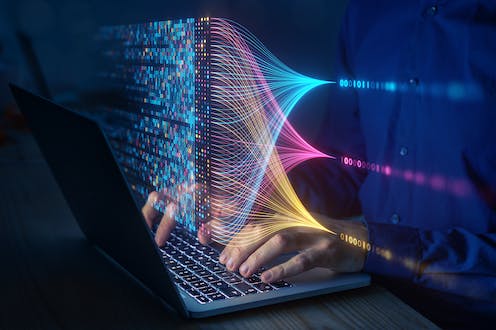\In the evolving relationship between technology and society, humans have shown themselves to be incredibly adaptable. What once left us breathless, soon becomes integrated into our everyday lives.
The astonishing functionalities of large language models (LLM) like ChatGPT were, just a few months ago, the epitome of cutting-edge AI. They are now on course to be mere add-ons and plugins to our text editors and search engines.
We’ll soon find ourselves relying on their capabilities, and seamlessly incorporating them into our routines.
Yet, this rapid acclimatisation leaves us with a lingering question: what’s next? As our expectations shift, we are left wondering about the next innovation that will capture our imagination.
People will try to achieve all kinds of smart – and not-so-smart – things with AI. Many ideas will fail, others will have a lasting impact.
Our crystal ball is not much better than yours, but we can try to think about what’s coming next in a structured way. For AI to have a lasting impact, it needs to be not only technologically feasible, but also economically viable, and normatively acceptable – in other words, it complies with the values that society demands we conform to.
There are some AI technologies waiting on the sidelines right now that hold promise. The four we think are waiting in the wings are next-level GPT, humanoid robots, AI lawyers, and AI-driven science. Our choices appear ready from a technological point of view, but whether they satisfy all three of the criteria we’ve mentioned is another matter. We chose these four because they were the ones that kept coming up in our investigations into progress in AI technologies.
1. AI legal help
The startup company DoNotPay claims to have built a legal chatbot – built on LLM technology – that can advise defendants in court.
The company recently said it would let its AI system help two defendants fight speeding tickets in real-time. Connected via an earpiece, the AI can listen to proceedings and whisper legal arguments into the ear of the defendant, who then repeats them out loud to the judge.
After criticism and a lawsuit for practising law without a license, the startup postponed the AI’s courtroom debut. The potential for the technology will thus not be decided by technological or economic constraints, but by the authority of the legal system.
Lawyers are well-paid professionals and the costs of litigation are high, so the economic potential for automation is huge. However, the US legal system currently seems to oppose robots representing humans in court.
2. AI scientific support
Scientists are increasingly turning to AI for insights. Machine learning, where an AI system improves at what it does over time, is being employed to identify patterns in data. This enables the systems to propose novel scientific hypotheses – proposed explanations for phenomena in nature. These may even be capable of surpassing human assumptions and biases.
For example, researchers at the University of Liverpool used a machine learning system called a neural network to rank chemical combinations for battery materials, guiding their experiments and saving time.
The complexity of neural networks means that there are gaps in our understanding of how they actually make decisions – the so-called black box problem. Nevertheless, there are techniques that can shed light on the logic behind their answers and this can lead to unexpected discoveries.
While AI cannot currently formulate hypotheses independently, it can inspire scientists to approach problems from new perspectives.
3. AutoGPT
We will soon see more new versions of AI chatbots based on the latest LLM technology, known as GPT-4. We’ll see AI that can handle different types of data, such as images and speech, as well as text. These are called multimodal systems.
But let’s gaze a little further into the future. Auto-GPT, an advanced AI tool released by Significant Gravitas, is already making waves in the tech industry.
Auto-GPT is given a general goal, such as planning a birthday party, and splits it into sub-tasks which it then completes by itself, without human input. This sets it apart from ChatGPT.
Auto-GPT incorporates AI agents, or systems, that make decisions based on predetermined rules and goals. Despite installation limitations, such an functionality problems when used with Windows, Auto-GPT shows great potential in various applications.
4. Humanoid Robots
Humanoid robots – those that look and move like us – have significantly advanced since the first Darpa Robotics Challenge in 2015, a contest where teams built robots to perform a series of complex tasks set by the organisers. These included getting out of a car, opening a door and drilling a hole in a wall. Many struggled to achieve the objectives.
However, startups are now developing “humanoids” capable of doing tasks like these and being used in warehouses and factories.
A report on the Darpa robotics challenge in 2015.
Advancements in AI fields such as computer vision, as well as in power-dense batteries which provide short bursts of high current, have enabled robots to navigate complex environments, maintaining balance dynamically – in real time. Figure AI, a company building humanoid robots for warehouse work, has already secured US$70 million (£55 million) in investment funding.
Other companies, including 1X, Apptronik and Tesla, are also investing in humanoid robots, which indicates that the field is maturing. Humanoid robots offer advantages over other robots in tasks requiring navigation, manoeuvrability, and adaptability because in part, they will be operating in environments that have been built around human needs.
Taking the long view
The long term success of these four will depend on more than just computation power.
Humanoid robots could fail to gain traction if their production and maintenance costs outweigh their benefits. AI lawyers and chatbot assistants might possess remarkable efficiency. However, their adoption might be halted if their decision making conflicts with society’s “moral compass” or laws don’t agree with their use.
Striking a balance between cost-effectiveness and society’s values is crucial for ensuring these technologies can truly flourish.



 Bitcoin Reserves Hit 5-Year Low as $2.15B Exits Exchanges – Bulls Quietly Loading the Spring Below $100K
Bitcoin Reserves Hit 5-Year Low as $2.15B Exits Exchanges – Bulls Quietly Loading the Spring Below $100K  Morgan Stanley Downgrades Tesla as AI Growth Expectations Rise
Morgan Stanley Downgrades Tesla as AI Growth Expectations Rise  IBM Nears $11 Billion Deal to Acquire Confluent in Major AI and Data Push
IBM Nears $11 Billion Deal to Acquire Confluent in Major AI and Data Push  SpaceX CEO Elon Musk Denies Reports of $800 Billion Valuation Fundraise
SpaceX CEO Elon Musk Denies Reports of $800 Billion Valuation Fundraise  Nvidia Develops New Location-Verification Technology for AI Chips
Nvidia Develops New Location-Verification Technology for AI Chips  Airline Loyalty Programs Face New Uncertainty as Visa–Mastercard Fee Settlement Evolves
Airline Loyalty Programs Face New Uncertainty as Visa–Mastercard Fee Settlement Evolves  Evercore Reaffirms Alphabet’s Search Dominance as AI Competition Intensifies
Evercore Reaffirms Alphabet’s Search Dominance as AI Competition Intensifies  ETH Whales on Rampage: BitMine Snags 138K ETH as $3,000 Holds Firm – Bulls Gear Up for $4,000 Moonshot
ETH Whales on Rampage: BitMine Snags 138K ETH as $3,000 Holds Firm – Bulls Gear Up for $4,000 Moonshot  Moore Threads Stock Slides After Risk Warning Despite 600% Surge Since IPO
Moore Threads Stock Slides After Risk Warning Despite 600% Surge Since IPO  SK Hynix Labeled “Investment Warning Stock” After Extraordinary 200% Share Surge
SK Hynix Labeled “Investment Warning Stock” After Extraordinary 200% Share Surge  Taiwan Opposition Criticizes Plan to Block Chinese App Rednote Over Security Concerns
Taiwan Opposition Criticizes Plan to Block Chinese App Rednote Over Security Concerns  ETH Bulls Smash Trendline – $4,000 Next as Whale Squeeze Tightens
ETH Bulls Smash Trendline – $4,000 Next as Whale Squeeze Tightens  SoftBank Shares Slide as Oracle’s AI Spending Plans Fuel Market Jitters
SoftBank Shares Slide as Oracle’s AI Spending Plans Fuel Market Jitters  Silver Spikes to $62.89 on Fed Cut – But Weekly Bearish Divergence Flashes Caution: Don’t Chase, Wait for the Dip
Silver Spikes to $62.89 on Fed Cut – But Weekly Bearish Divergence Flashes Caution: Don’t Chase, Wait for the Dip  SK Hynix Shares Surge on Hopes for Upcoming ADR Issuance
SK Hynix Shares Surge on Hopes for Upcoming ADR Issuance 

































